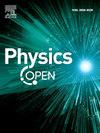Laser assist quantum dot scattering with Gaussian potential
IF 1.4
Q2 Physics and Astronomy
引用次数: 0
Abstract
Laser-assisted quantum dot (QD) scattering with a Gaussian potential explores the interaction of QDs with incident laser fields, influencing their scattering dynamics with several parameters. It has wide applications in quantum computing, nanophotonics, optoelectronics, precise quantum state manipulation, biosensing, medical imaging, and photovoltaics, where laser control enhances QD performance for improved efficiency and sensitivity. This study investigates the differential cross-section (DCS) in laser field with QD (dressed gaussian potential) and field free electron. This is theoretical work, to developed new model of DCS for considered system, Kroll-Watson approximation, Volko wave functions and S-matrix and T-matrix are used as theoretical tools. After the development of model different parameters are used like incidence energies (0 to 5 eV), scattering angles (0 to 60°), QDsizes (0 to 10 Å), and laser-dressed parameters (0 to 40 Å) to study the nature of DCS, for validation of parameter's authors used secondary data from published work. The nature of developed equation was computed using MATLAB online student package. The observation shows that the DCS decrease with increasing in incident energy of electron and scattering angle while increase with QDs size as well as laser-dressed parameters. Also, the observation shows DCS for zero-order Bessel function is higher DCS than other higher order Bessel function. Additionally, the observation also shows DCS for elliptical polarization found higher than linear polarization. This shows DCS is effects by different parameters as well as assumption consider in this study. This means the system also goes effect when such QD is used in applied field as mention above. So, it is necessary to study the DCS of QD under various condition.
高斯势激光辅助量子点散射
高斯势激光辅助量子点(QD)散射探索了量子点与入射激光场的相互作用,影响其散射动力学的几个参数。它在量子计算、纳米光子学、光电子学、精确量子态操纵、生物传感、医学成像和光伏等领域有着广泛的应用,其中激光控制增强了量子点的性能,从而提高了效率和灵敏度。本研究探讨了激光场与 QD(穿戴高斯势)和场自由电子的微分截面(DCS)。这是一项理论工作,为了为所考虑的系统建立新的 DCS 模型,使用了 Kroll-Watson 近似、Volko 波函数以及 S 矩阵和 T 矩阵作为理论工具。在建立模型后,使用了不同的参数,如入射能量(0 至 5 eV)、散射角(0 至 60°)、QD 大小(0 至 10 Å)和激光穿透参数(0 至 40 Å)来研究 DCS 的性质,为了验证参数,作者使用了已发表作品中的二手数据。使用 MATLAB 在线学生软件包计算了所建立方程的性质。观察结果表明,DCS 随电子入射能量和散射角的增加而减小,但随 QDs 尺寸和激光处理参数的增加而增大。观察结果还显示,零阶贝塞尔函数的 DCS 比其他高阶贝塞尔函数的 DCS 高。此外,观察还发现椭圆偏振的 DCS 比线性偏振的高。这表明 DCS 受本研究中考虑的不同参数和假设的影响。这意味着在应用领域中使用上述 QD 时,系统也会受到影响。因此,有必要研究 QD 在各种条件下的 DCS。
本文章由计算机程序翻译,如有差异,请以英文原文为准。
求助全文
约1分钟内获得全文
求助全文
来源期刊

Physics Open
Physics and Astronomy-Physics and Astronomy (all)
CiteScore
3.20
自引率
0.00%
发文量
19
审稿时长
9 weeks
 求助内容:
求助内容: 应助结果提醒方式:
应助结果提醒方式:


